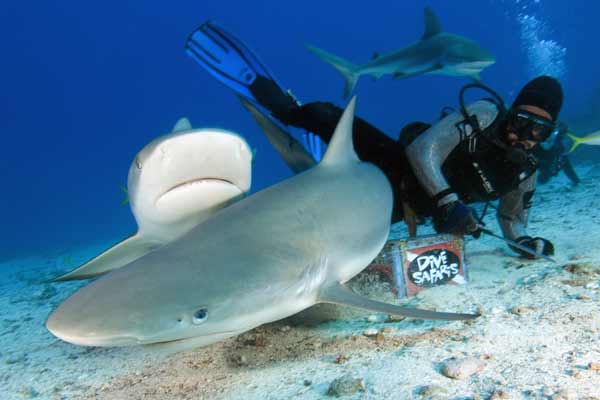I thought I’d seen
every type of shark dive that the Caribbean has to offer, but here I am on the
Dutch side of St Maarten, on a shark feed with boisterous Blacknose sharks.
South of the Bahamas, few
people have even heard of Blacknose sharks, but at Big Mama’s Reef, shark
feeders regularly don chain mail and enter the arena with these frisky little
animals. The Blacknoses (aka Carcharhinus acronotus) arrive early and
dart about, ready to snatch whatever morsels they can, before the larger
Caribbean reef sharks muscle their way to centre stage. Once relegated to the
wings, the Blacknose sharks circle patiently, hoping that something tasty will
drift their way.
Blacknose sharks can be
found from the Carolinas down to Brazil, but in the Caribbean they are rarely
seen on scuba dives and unheard of at shark feeds. Why they choose to join the
feed at St Maarten, is still a mystery. It may be because comparatively few
Caribbean reef sharks come to dine here. At certain times of year, when the
reefies are busy mating or off in deep water, the one meter long Blacknose
sharks have the feed all to themselves. Then, these normally timid animals
become extremely aggressive, launching with abandon at the bait, from all
directions.
On today’s dive, the reef
sharks are here in force and it is tough to get close to the Blacknoses. From
a distance they blend easily with the gray/blue seascape but occasionally one
makes a close enough pass to be illuminated by my camera strobes. Under this
artificial light they glow a fiery bronze, contrasting deeply with their
monochrome surroundings. The dark smudges on the very tips of their noses
(that give them their common name) are barely discernable on these
individuals, and for a long time no one here was quite sure what species they
were.
Whitney and Bobby Keough are
the owners of St Maarten’s largest dive operation - Dive Safaris. They have
been developing their ‘shark awareness dive’ for the last seven years.
Jefferson (their Brazilian feeder) has the Caribbean reef sharks very well
trained. His favorite stance; kneeling with one knee raised, allows him to
corral the big sharks between his legs towards the bait. He says that
straddling them in this way protects his hands, but I’m not convinced of his
wisdom. Each time the excited sharks blindly barrel through (inches from his
unprotected crotch), I wince involuntarily, visualizing tomorrow’s headline:
Shark Feeder castrated by Caribbean reef shark!
Multiple sharks converge in
tightening circles around the armor clad Ring Master. Jefferson casually flips
one over, demonstrating his skill in placing the sharks into a state of tonic
immobility. Amid the heightened activity, endless streams of bubbles escape
from the wide eyed divers, many of whom have never seen sharks before. The
reef sharks on the other hand, are regular visitors and have been allocated
names like Big Mama (a truly gargantuan reef shark), Scratch (who is blind in
one eye), and Xena (a warrior princess if ever I’ve met one). There are a
dozen sharks of all sizes present at this feed but the numbers vary daily.
Dive Safaris is extremely conscious of the potential impact of shark feeding
and they try to limit the encounters to a few days a week. During the pre-dive
briefing there is a firm emphasis on shark conservation, and the feeders go
out of their way to convince the nervous divers that the sharks do not deserve
their blood thirsty reputation.
Armed with eye popping images
of the feisty reef sharks, I retire topside to sample some of St Maarten’s
other attractions. Although the island is surrounded with colorful coral
reefs, the majority of visitors come here to enjoy the ‘anything goes’ Dutch
attitude. As the sun sets dramatically over the volcanic landscape, the guava
berry rum and one dollar beers begin to flow. Exhausted by the intense shark
dives and the endless party spirit, I ask Whitney (who is a complete shark
junky) how her crew keep up the pace. She shrugs “if you live here, you get
used to it”. “Soon” she adds “we plan to experiment with offshore chumming for
Tigers and other large sharks”. In such a rich and varied environment, who
knows what other interesting species will turn up? I guess I’ll have to come
back and find out.






















